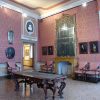In this room you can admire the third of Giambattista Tiepolo’s four ceilings in Ca’ Rezzonico. This modelled canvas shows Nobility and Virtue defeating Wickedness. Unlike the frescoes in the other rooms of the lower piano nobile, this work was not painted for the palace, but was created between 1744 and 1745 for Pietro Barbarigo for his palace in Santa Maria del Giglio. Later it was removed by his heirs and purchased in 1934 by the Venice Town Council to be exhibited in this room.
In this work, Tiepolo goes back to an allegorical theme he had already used various times for his noble patrons. This time he adds the figure of the elegant page bearing the train of Nobility, who is perhaps the portrait of his son Giuseppe Maria.
The splendid figures of the allegories stand out from a sky of crystalline luminosity. The painting has a consistently light colour scheme with grey/silvery overtones which emphasise the iridescent orange of Virtue. In this case too Tiepolo was evidently greatly inspired by Paolo Veronese’s use of bright colours, but the pungent sensuality of the figures and the free, flowing application of the paint is wholly 18th-century in character.
An important painting in this room, high up on the wall to the left of the entrance, is the Portrait of the Architect Bartolomeo Ferracina, by Alessandro Longhi, the son of Pietro Longhi and the most famous late 18th-century Venetian portrait painter.
The furniture in this room is of different origins and high artistic value. The imposing walnut bureau-trumeau is unique for its size, workmanship and state of conservation, and was perhaps original to the palace. It is datable to the mid-18th century. The large eight-legged billiard table with its green felt-covered top in the middle of the room is particularly interesting. It is a fine example of Venetian Baroque furniture, and its massy, monumental forms and lion-paw feet suggest that it was probably made in the late 17th or the early 18th century. The eight carved boxwood armchairs formerly belonged to the Correr family and were traditionally attributed to Andrea Brustolon, but considering the inferior quality of the carving are more likely to be the work of his workshop or of a contemporary imitator.
The door between the bureau-trumeau and the fireplace leads to a narrow passageway displaying white porcelain groups produced by the Venetian manufactory of Geminiano Cozzi and the one operated by Pasquale Antonibon in Nove.

